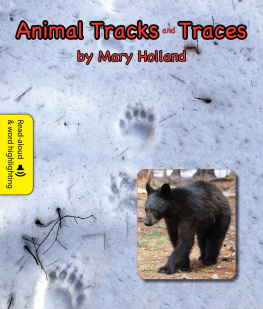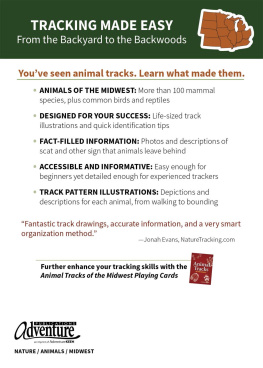CONTENTS
Guide
MY FIRST DEBT OF GRATITUDE IS TO 22 SPECIAL AIR SERVICE Regiment and the New Zealand Special Air Service and all their highly talented jungle instructors who taught me tracking and, most importantly, introduced me to the Iban trackers of Brunei from whom I was able to learn a great deal by observing their methods.
Also I would like to thank Roy Thomasson, not only for his illustrations, which breathe life into the subject matter, but also for his support throughout this enterprise, especially in the early stages when his encouragement sustained me. Thanks are also due to Stewart Birch for his help in editing and writing, and Anne Harbour for her unstinting professional help in ensuring this edition became a reality.
Finally, I want to thank those members who are no longer with us for their contributions that helped me write this book.
PEOPLES FIRST COMMENT, OR AT LEAST THEIR FIRST THOUGHTS, when they hear an account of an incident where tracking has been employed is something along the lines of, How unusual! It is as if the skills associated with trackers and tracking had died out long ago, and the disciplines had no relevance to modern life. My aim is to dispel this misconception and to open up the benefits of tracking to a much wider audience. At the moment there are, it seems, only two groups who are aware of the usefulness of the trackers knowledge in modern society.
First, there are the specialist military units who have kept the skills alivedespite great resistance from some quarters of the military establishment. And second, there are the rural police forces who have brought in trackers, usually ex-military, on a case by case basis but who rarely have a formal training program for their own trackers.
In my opinion this is a sad under-utilization of a wealth of knowledge that our ancestors have built up over millennia. I believe that tracking can play a wide and valuable role in modern society. In this new edition there is a chapter devoted to the digital ageand how it enhances the value of the tracker as opposed to making the trackers skills redundant.
A HISTORICAL PERSPECTIVE
The tracking skill initially developed because of mans desire for meat. Naturally weaker than most of his prey and having only primitive weapons, man was forced to use other skills. He had to observe the areas frequented by and the habitats of the animals and birds he intended catching for food.
This basic feature is reflected even today in that some of the best game trackers in the world come from the more remote areas where they live a very unsophisticated existence close to nature. Often their way of life, customs and social habits are dominated by the game chase and the after catch celebrations. A classic example of this hunting-centered lifestyle was the Great Plains Indians of North America. They migrated with the game herds that not only provided them with food, but also clothing, ornaments, tools, shelter, and fuel. It is not surprising that their dances and their spiritual life were fashioned around the buffalo and the other animals that supported them. This is just one example of how fundamental hunting and therefore tracking are to mankind.
Even after man had domesticated animals and cultivated the land, tracking did not become redundant. It was a skill in his arsenal when warring against other tribes. He soon found that even with inferior numbers and weapons, by employing stealth, cunning, surprise, and superior knowledge of bush craft he was able to overcome and defeat his victims. Reprisals and revenge naturally followed, and so tracking and scouting skills were firmly established in warfare.
The vast majority of the civilian population and even military leaders and police chiefs are unaware of the potential use of trained trackers, but, with some imagination, it is not difficult to envisage trackings many uses.
LAW ENFORCEMENT AGENCIES
Tracking with most law enforcement agencies is orientated primarily towards scent tracking, employing highly trained trackerdogs. Their work ranges from the pursuit of law-breaking fugitives to the detection of explosives and narcotics. The US border patrol is but one enforcement agency that currently employs these tracking techniques in its never-ending task of stopping illegal entry into the United States.
Scent tracking is established as a useful tool but the same enthusiasm has not yet extended to visual tracking, where expertise could equally well be used. To limit the use of tracking to scent tracking is to impose a severe limitation. The visual tracker can be especially useful in rural areas. Speaking from experience of having trained an anti-poaching unit (APU) in Botswana, I know how useful, and lethal, visual trackers can beas do the unfortunate Zimbabwean poachers who tried to outrun and out-shoot our APU.
In my opinion there are two areas in which visual trackers should be involved with police work. First, there should be a pool of federally certified trackers who are on call to local law enforcementrather like interpreters are on call. And second, they have a briefing role: to explain to senior officers the applications of visual tracking and to make all officers aware of the importance of preserving the sign (see ) for the tracker.
THE MILITARY
Recent military tracking provides many examples of the application of this ancient skill. It is man tracking man, either to gain information or to kill him. The low-intensity, counter-insurgency wars of the post-colonial era provide many examples of the employment of trackers. It is such a rich and varied field that I have devoted a whole chapter to it (see ). But even here, once the conflicts have been resolved, the tracking units are usually disbanded and the men reassigned, thus dispersing and eventually losing the pool of skills. The New Zealand SAS is one unit that has had the foresight to keep tracking skills as an essential component of the military curriculum.
The benefits of preserving the knowledge and skills of a tracker within a military establishment are twofold. First, the training that a tracker undergoes can be seen as honing the skills that any infantry soldier needsobservation, movement and concealment. And second, the skills are ready for immediate utilization by the higher commands in such remote area emergency situations as search and rescue of downed pilots, as in Iraq or Bosnia, when the TACBE (the emergency location beacon carried by aircrew) may have been lost, damaged, stolen, or removed if the aircrew have been capturedor it simply ran out of power.
Cave and Mountain Rescue
Rescue organizations are often called upon to locate missing persons. Unfortunately, they possess limited or no knowledge of the arts of tracking. Consequently a great deal of sign (see ) is normally obliterated by the first person on the scene, making it almost impossible for any immediate pursuit by trained trackers. Vital time is wasted and the results can be tragic.
CONSERVATIONISTS
For the nature enthusiast, whether a professional paid conservation officer or the unpaid amateur working for the Royal Society for the Protection of Birds (RSPB), there is a great benefit to be had from a proper grounding in tracking. With a fuller understanding of what is happening in a particular environment they gain a greater satisfaction from their pursuits, and professionals are better placed to protect species and encourage the development of the wildlife.
GAMEKEEPERS
As any professional gamekeeper knows, he is now protecting a very valuable asset for his employer. Land and livestock are under threat from ruthless, well-organized gangs, both local and, perhaps more importantly, from out of area. These criminals do not enter a region on a whim. They plan their raids with precision because they know the profits to be gained are huge. The knowledge that a trained tracker could elicit from studying the areas either where raids have taken place or, even better, where the reconnaissance and preparation for a raid have taken place would be an invaluable weapon in the anti-poaching units armory. This is not just of relevance to the African government trying to protect its stock of rhino but also to the Yorkshire or Scottish gamekeeper trying to preserve stocks of pheasants and salmon.




